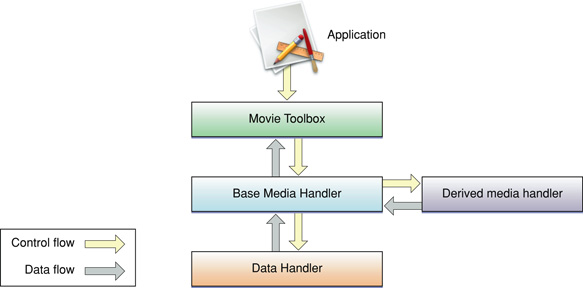About QuickTime Media Handler Components
This chapter provides background information about media handler components in general and explains the difference between media handler components and derived media handler components. After reading this chapter you should understand why media handler components exist and whether you need to create a derived media handler component.
Media Handler Components
Media handler components allow the Movie Toolbox to play a movie’s data. The Movie Toolbox, by itself, cannot read or write movie data. Rather, media handlers perform input and output services on behalf of the Movie Toolbox. The Movie Toolbox gains access to the appropriate media handler for a particular movie track by examining the track’s media. That data structure identifies the media handler that created and maintains the media.
Each media handler is primarily responsible for understanding the format and content of the media type it supports. The media handler is intimately familiar with the sample structure used in its media, the compression techniques used to store the media’s sample data, and the performance characteristics of the device that stores the media.
During movie playback, the media handler draws its media’s data on the screen and plays the media’s sounds. The media handler may use the services of other managers such as the Image Compression Manager for compressed image data and the Sound Manager for sound data. When an application creates a movie, media handlers store the movie’s data. The actual reading and writing of media data are performed by another component, the data handler.
Applications never directly use the services of media handlers. The Movie Toolbox controls all movie data storage and retrieval on behalf of QuickTime applications.
Figure 1-1 shows the logical relationships between applications, the Movie Toolbox, media handlers, and data handlers.

Apple had three primary goals for isolating the Movie Toolbox and QuickTime applications from the details of media data access. First, the isolation allows programmers who develop the Movie Toolbox and QuickTime applications to focus on the specifics of the problems they are addressing, freed from concerns about data access. Second, this architecture allows QuickTime to be easily extended to accommodate new storage devices and technologies. Third, by documenting the media handler interface, developers can create their own, special-purpose media handlers that work with QuickTime.
Derived Media Handler Components
Much of what a media handler component must do is common to all media handlers. Managing a connection with the appropriate data handler, retrieving movie data from media samples, and storing movie data into new samples account for a substantial part of every media handler’s responsibilities. To make it easier for developers to create media handler components, Apple provides a base media handler component that performs most of the common duties of a media handler.
Apple’s base media handler component eliminates much of the work you would have to do to create your own media handler component. The base media handler interacts with both the Movie Toolbox and the appropriate data handler, so that your media handler only has to deal with service requests, and you can ignore many of the housekeeping functions. It understands the format of Apple’s media samples and sample descriptions, so that your media handler only has to worry about the actual media data. Finally, it provides basic services that your media handler can use to accommodate unusual display environments.
When you build your media handler component on top of the base media handler, your media handler is known as a derived media handler component. This terminology is borrowed from object-oriented development and refers to the fact that your media handler is based on, or derived from, the services provided by Apple’s base media handler. All media handlers written by developers are derived media handlers, because they all use the services of the base media handler. Figure 1-2 shows the relationship between the base media handler, derived media handlers, the Movie Toolbox, and data handler components.

Copyright © 2005, 2007 Apple Inc. All Rights Reserved. Terms of Use | Privacy Policy | Updated: 2007-01-08